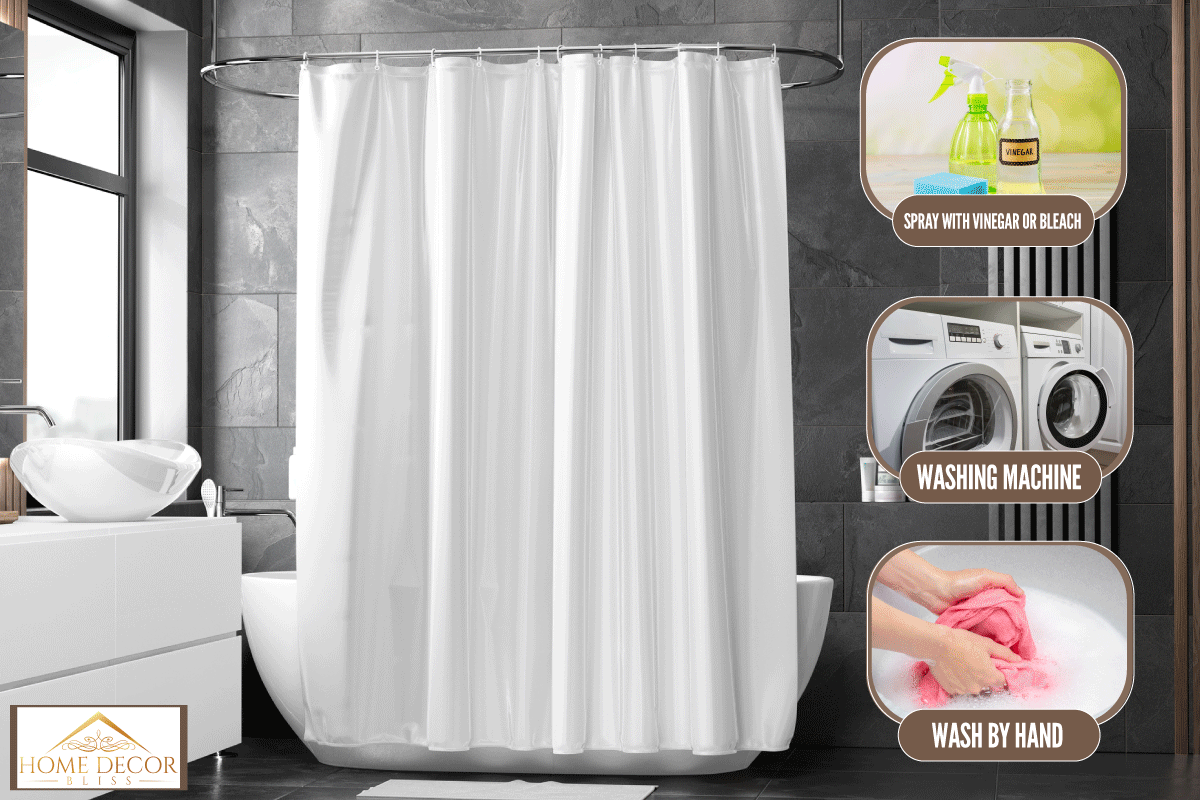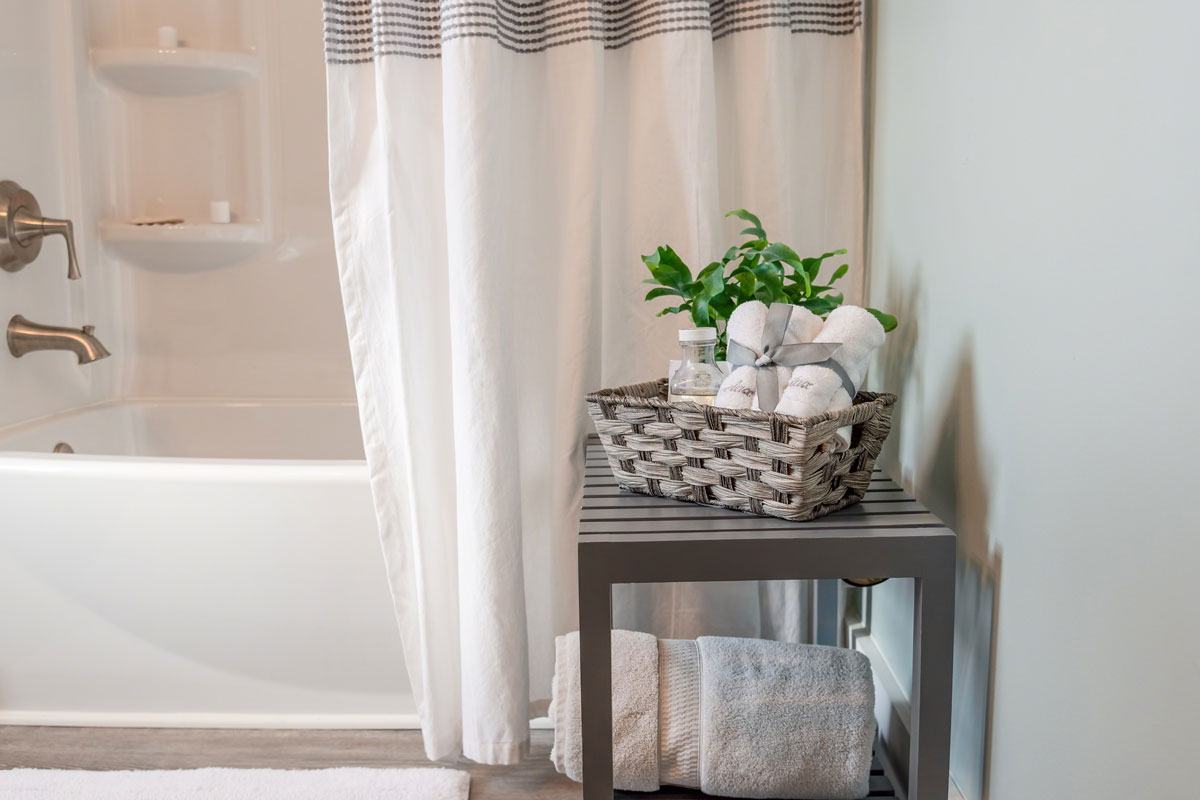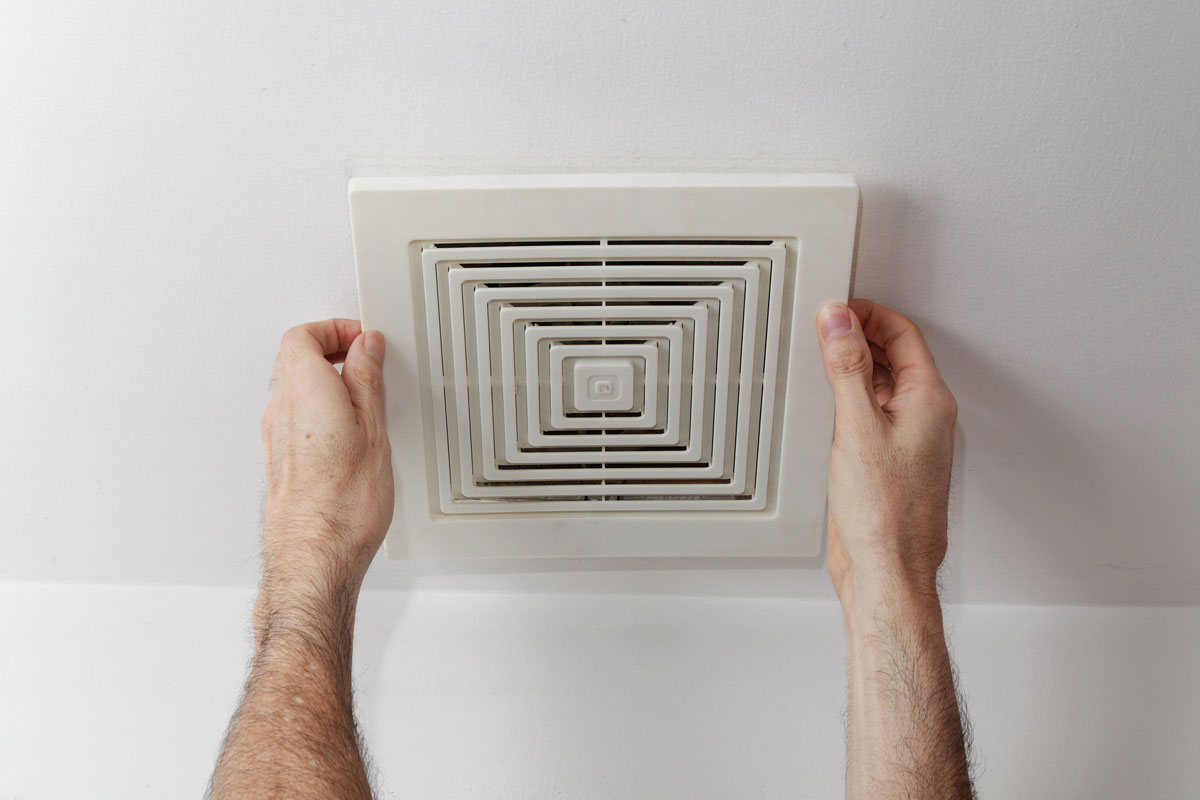Having a pleasant shower experience is only possible if everything is clean--especially the shower curtain liners. Though they are an obvious bathroom fixture, we sometimes don't pay them any mind. However, being subjected to excessive moisture can cause bacteria to grow on them, so how do you clean fabric shower curtain liners? We have researched answers to find out.
Cleaning your shower curtain liner is a simple enough task. Here's how you can do it:
- Spray the hanging curtain with a bleach solution
- Remove the curtain from the rod and throw it into a tub or washer
- Add one tablespoon of bleach or one cup of baking soda to eliminiate any mold
- Wash it by hand, scrubbing it vigorously
- Rinse, air dry, and hang
If you're using a washing machine, put one tablespoon of bleach along with one tablespoon of detergent. If there are stubborn stains, scrub the spots with baking soda.
There are many effective methods to remove mold and mildew on your shower liners. The most efficient method will depend on how much dirt is present. If you want to learn more about cleaning fabric shower curtain liners, keep reading below.

How To Clean A Fabric Shower Curtain Liner
If you start noticing specks of grey and pink on your shower curtain, you've been inadvertently growing colonies of organisms inside your bathroom. If it gives you the shivers, good--it means you should now wash your shower curtain liner!
It's important to clean your shower every other week since bacteria tends to grow slowly; you might not even notice it's there at first. You wouldn't want to inhale microbes that can get you sick while taking off dirt--which is both ironic and dangerous.
We sometimes add affiliate links and content that was curated and created by our team with the help of advanced ai tools to help showcase the best design styles.

Here is how you can effectively clean your shower curtain liners and enjoy a fresh, clean bathroom.
Read: "How High Do You Hang A Shower Curtain?"
Spray the Hanging Curtain with a Bleach Solution
Before washing, spray the curtain's surface first with a bleach solution (try color-safe formulated bleach for a brightly colored liner). You can spot-test the bleach first to ensure it won't damage the liner. This will specifically target the mold and bacteria, letting the stubborn stains lift so they will easily be removed in the washer.
Simply mix equal parts of bleach (again, color-safe formulated bleach if needed) and water and pour it into a spray bottle. Target the most problematic areas and graze the entire surface too. Wait for 10-15 minutes, then remove the curtain.
Remove the Curtain from the Rod and Throw It Into a Tub or Washer
Once you've sprayed it with a bleach solution, remove the curtain from the rod and fill up a tub with warm water. Then, fill it with detergent and one cup of baking soda for best results.
If you're washing it by hand, scrub the curtains vigorously on each section. The hem and underside of the curtains are usually the dirtiest parts, so pay extra close attention to them.
Add one Tablespoon of Bleach or one Cup of Baking Soda to Eliminate Any Mold
If you notice that there are still stains and mold that won't budge, target them again with the bleach solution and scrub them by hand. For more favorable results, sprinkle a teaspoon of baking soda as well.
Baking soda should be able to neutralize the acid that caused the stain, as well as remove possible odors that might have resulted from bacteria buildup.
Does Vinegar Help with Mold Build-up?

You can also try treating mold with one cup of distilled white vinegar. It has antifungal and antibacterial properties that eliminate bacteria, fungi, and about 82% of mold.
Vinegar is sometimes more effective than bleach since it doesn't leave residual molds that can repeat the cycle of the outbreak. When you treat your shower curtain with vinegar, make sure to let it sit for one hour before rinsing.
Wash it By Hand, Scrubbing it Vigorously
Handwashing is sometimes more effective than simply putting the curtain in the washer since you'll get to target specific areas. Take the curtain out of the washer then put it in a tub filled with detergent and scrub the stubborn stains.
If you put bleach on it, or if you treated spots with vinegar, make sure to wear hand gloves to protect your skin.
Rinse, Air Dry, and Hang
Rinse the curtain free of suds. To do this, drain the tub and refill the tub with water, squeezing the curtain for soap residues and repeating the process until the water is clear.
Even if your shower curtain underwent a spin cycle, you should still let them completely air-dry before hanging them back up.
Drying them under direct sunlight also helps since the sunlight can better disinfect fabrics, discouraging mold growth on your shower curtain liners.
The UV rays will be beneficial, especially for white sheets such as towels and curtain sheets which are often vulnerable to bacteria because of their dampness.
Can you wash plastic curtain liners?
You can wash the plastic curtain liners, either by handwashing or by putting them in the washer.
However, if you put it in the washer, make sure you mix it in with other sheets and towels. Also, don't put the plastic curtain in the dryer as this could warp the material.
Keep the washer in a cool setting, and make sure to air dry it afterward. Wash it using color-safe bleach, so the color doesn't fade while disinfecting, and use vinegar for hard-to-treat molds and stains.
To be safe, read the care instructions that came with the plastic curtain to be certain that it can be put into the washer.
How To Ventilate Bathrooms
If you don't want your shower curtain liners to get moldy in the first place, you need to ventilate your bathroom well. Ventilation will prevent condensation, which will protect your surfaces from mold and bacteria buildup.
Having a reliable ventilation system is important in damp places in the house, such as the kitchen, but more importantly, the bathroom.
It's natural for the bathroom to have excess vapor, especially when you shower, but you need to make sure that vapor doesn't get trapped as it can seep into the corners of your bathroom and let fungi and mildew fester.
Here are ways you can eliminate humidity in the bathroom and protect your curtain liners from bacteria.
Install an Extractor Fan

Extractor fans pull out the excess moisture in the bathroom so it can feel clean and dry after use. Simply open the fan during your shower, then leave it running for 20 minutes more after stepping out.
Extractor fans prevent your bathrooms from smelling musty, and they protect your bathroom fixtures from moisture buildup.
You can install either an axial fan that connects directly to an exterior wall or a centrifugal fan that can distribute air over a long distance. If the exterior walls are over 140 feet (40 meters) away, you can have an inline fan installed.
See this extractor fan on Amazon.
Get a Dehumidifier
Dehumidifiers are also effective in removing the damp air in your bathroom. This can be an ideal temporary solution if you can't install an extractor fan yet. However, it is best combined with the mechanisms of an extractor fan.
Get a dehumidifier that can carry as much as 12 liters of water since the air in the bathroom can get heavy, especially if you take long showers.
Be careful where you place the dehumidifier as it can get water-damaged.
See this dehumidifier on Amazon.
Open the Window
Opening a window after you shower can ventilate your bathroom. You can also crack it open while you shower if you have enough privacy outdoors or if you are facing your own yard.
However, if you don't have enough privacy and are yet to install a ventilation system, open the windows and let the damp air out for 15-20 minutes after showering. This should be enough time to remove the dampness in the air.
For best results, try airing out the bathroom using a fan, with the direction facing the window. This can dry out your bathroom quicker, diluting the humidity and helping to release the air outside.
Read: "What’s The Best Window For A Shower? [8 Great Ideas!]"
Open the door after showering

Another great way to ventilate the bathroom is to simply leave it open after you shower. This will let out odors from the bathroom and prevent the damp air from seeping into corners and housing bacteria.
Letting air circulate and injecting clean air into the bathroom will improve its ventilation. You can also spray disinfectant, but you need to air it out for a longer time.
However, it is still best to combine this method with other mechanical ones, such as installing a vent and a humidifier.
Final Thoughts

Fabric shower curtain liners are useful fixtures that can limit the water splash that goes over the vanity area. So, if you want to keep it fresh and clean, you need to make sure you wash it at least once weekly.
This will ensure that you remain safe and healthy and that your shower experience remains pleasant.


